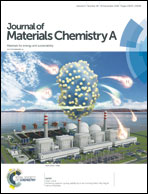CO2 electrolysis in seawater: calcification effect and a hybrid self-powered concept†
Abstract
Oceans are regarded as a sink for anthropogenic CO2; as such seawater provides an attractive electrolyte for electrochemical CO2 reduction to value-added carbon-based fuels and chemical feedstocks. However, the composition of seawater is inherently complex, containing multiple cations and anions that may participate in the CO2 electroreduction reaction. Herein, examination of a nanoporous Ag electrocatalyst in seawater reveals a significant influence of calcium ions on the electrochemical CO2 reduction performance. Under the applied cathodic potential and in the presence of CO2, calcium ions in the seawater result in calcium carbonate deposition onto the nanoporous Ag, reducing active sites for CO2 electroreduction. Mitigation of calcification would promote a stable CO2 electrolysis in seawater. A first proof-of-concept self-powered hybrid CO2 electrolysis is demonstrated by the coupling of a Mg anode to a nanoporous Ag cathode in 0.6 M NaCl or seawater. A spontaneous oxidation of a Mg alloy at the anode drives cathodic reduction of AgCl to nanoporous Ag, which electrocatalytically reduces CO2 to CO. Combining galvanic and electrolytic properties in a single electrochemical cell offers a general approach for designing hybrid self-powered electrolysers. Strategies to overcome calcification such as removal of calcium from the seawater and development of anti-calcifying electrocatalysts are needed to promote practicability of seawater as an electrolyte in CO2 electroreduction technology.



 Please wait while we load your content...
Please wait while we load your content...